As a company (i.e. Global-Roam Pty Ltd), we’re coming up on the end of our 20th year of operations, and what a journey it’s been! We’ve appreciated the opportunity to serve a large and diverse range of clients (both those who’ve been with us for 10 or 15 years – and also those who just came onboard, or came back, in 2019).
Over this journey we have been using our software to watch the market for a variety of different reasons. It was around 2007, I think, when we began to formalise some of this “NEM watching” with the inception of this WattClarity® industry commentary site, which has continue to grow from strength to strength since that time. We watch the NEM a lot!
Over the years of watching the NEM, I can’t recall too many weeks like the extreme week that’s just coming to a close – which is ordinarily a pretty non-eventful time in the leadup to Christmas with schools closed and many already on holidays (including our a-little-less-respected PM, coincidentally). All going well our highly valued guest author, Allan O’Neil, will be taking a deeper look at some of what’s unfolded through the week with an article or two that should go live sometime over the next week or so.
However curiosity’s got the better of me this afternoon, so I thought I would have a quick look at what happened yesterday afternoon in the Victorian region of the NEM.
(A) Broad overview
Using this trend on NEMreview v7 I have produced this view of the high level stats for what unfolded through the day:
Temperatures* pushed well past 40°C across much of the state driving Operational Demand past 9,000MW (which would not ordinarily be worth much comment, given that peak all-time record is 1,500MW or so beyond that level).
* as per the annotation, some more learned Weather Watcher can explain the reason for such a large deviation between temperature and apparent temperature?
For approx 4 hours through the afternoon we saw Victorian demand push beyond the aggregate level of available generation capacity in the state, highlighting the need for imports from interconnected South Australia, Tasmania and New South Wales. Whilst this is not an uncommon event during times of high demand, coincident hot weather in South Australia (the 4th day in a row) drove demand there and interconnection capacity from Basslink and New South Wales was maxed out at times through this period.
As a result the dispatch price in Victoria produced major spikes at 17:20 ($14,499.99/MWh) and at 17:35 ($11,500.80/MWh) which drove the trading price for the hour-long period from 17:00 to 18:00 well past $1,000/MWh.
However if this was all that happened, it would not be all that noteworthy as one of the more volatile days of summer (of which there are typically always some).
(B) Particular points of interest
I’m presuming that Allan will probably highlight other particular points from Friday that peaked his curiosity, as part of his broader review of the week-that-was. Just wanted to flag two big ones from my perspective:
(B1) Loy Yang A2 did not return in time
Firstly it is worth noting that, contrary to earlier advice from AGL Energy, Loy Yang A2 did not return in time to make a contribution to the Victorian region through Friday (or indeed even Saturday as I write this).
Whilst these sorts of slight delays are completely understandable given the complexity of the 6-month repair process that has been undertaken, it’s particularly noticeable given that we’ve all been sweating on the return of the Loy Yang A2 unit (and also Mortlake 2 – which has an expected return date of 30th December I believe).
(B2) Surprise notice of LOR2 commencement, and RERT Negotiations
My sense is that what unfolded through the day did not go to plan – firstly for AEMO and hence also for Market Participants and broader stakeholders (it certainly provided ample distractions through the afternoon for us in our role).
The following table sums up a rough sequence of events highlighting the unexpectedness of certain events – leading to other outcomes that surprised the broader market:
| Trading Period (i.e. half-hour ending)
NEM Time |
VIC Trading Price | What happened
(click on images for a full-screen view) |
| 12:30 | $148.20/MWh | Beginning around 12:30 there appears to be a significant deviation open up between AEMO’s forecasts for the (aggregate) Available Generation capacity across all Semi-Scheduled Wind Farms in VIC and what the actual availability was.
See charts below. |
| 13:00 | $291.60/MWh | . |
| 13:30 | $267.27/MWh | . |
| 14:00 | $184.92/MWh | It was around 13:55 that I finally finished my not-so-quick review of the volatility seen the previous day (Thursday) in South Australia. Whilst I was finishing off that article, a different drama was evolving in the Victorian region on Friday. |
| 14:30 | $343.10/MWh | . |
| 15:00 | $324.91/MWh | . |
| 15:30 | $162.56/MWh | At 15:21 the AEMO publishes Market Notice 71921 which announces forecast LOR1 condition in Victoria from 17:30 to 18:00 on this day.
For those not so familiar with NEM Jargon here’s a brief description of the LOR (Low Reserve Condition) warning system. |
| 16:00 | $268.53/MWh | . |
| 16:30 | $185.48/MWh | At 16:15 the AEMO publishes Market Notice 71932 which extends the forecast LOR1 condition in Victoria from 17:00 to 18:00 on this day.
At 16:17 the AEMO publishes Market Notice 71933 about limitations with respect to the transfer capability on the two interconnectors between VIC to SA: ———————– There is a short notice outage of the Heywood M1 500/275 kV Transformer (Vic region). The outage is scheduled from 1355 hrs until further notice The constraint sets contain equations the following interconnectors on the LHS ———————– … though note that the extremes in temperature seen in South Australia were also meaning extremes in demand there, and (with downward trend in wind/solar output) hence limited spare capacity to export SA to VIC in any case. |
| 17:00 | $200.03/MWh | Around 16:40 (after puzzling about a large discrepancy between forecast and actuals for UIGF + TotalIntermittentGen in the Victorian region and discussions with several people) I thought it would be useful more broadly to post a message on social media (here on Twitter, and here on LinkedIn) to publicise this fact more broadly.
Here’s the image that I posted at the time: As noted in the image (click on image for a fuller view), I wondered whether this was a copy-book case of where the extreme temperatures besetting Victoria were having the impact of limiting maximum output capability, as explained previously here on WattClarity® with the example of the Ararat Wind Farm (a.k.a. the “mystery DUID”) – and explored more fully for all DUIDs (of all Fuel Types) in our Generator Report Card 2018. |
| 17:30 | $2,518.98/MWh | I tweeted here about the following NEMwatch v10 snapshot for 17:05 (click on image for a fuller view) showing IRPM down at only 12% (i.e. 1,383MW) in the SA+VIC Economic Island created because of constrained flows in from TAS and NSW:
Whilst ordinarily a surplus of 1,383MW I was quite nervous about how much of this could actually be counted on if an unknown amount of supply from wind and solar that AEMO was counting on in the predispatch time points ahead was not actually turning up when those time points arrived. There’s also an interesting (and sizeable) drop in demand in South Australia shown in the image for a couple hours earlier in the day, but that’s food for another exploration at some point. I presumed that AEMO was also nervous about this – because at 17:03 the AEMO publishes Market Notice 71934 announcing the intention to commence RERT Negotiations (i.e. Reserve Trader) for the period of time 16:30 to 17:30. The Market Notice says “AEMO will issue a further advice if reserve is contracted” and no further Market Notice was issued, so we presume no contracts were agreed? I tweeted about this Market Notice shortly before heading out the door on the walk home. Around 17:15:20 the AEMO will have published the dispatch price ($14,499.99/MWh) for the 17:20 dispatch interval – the prime reason the trading price ends up over $2000/MWh. Here’s a view of this particular dispatch interval using a 4-widget window in ez2view (click on image for a fuller view) time-travelled back to this first spike at 17:20: As shown clearly in this view, Victoria is quite close to running out of spare capacity at this point (and presumably South Australia as well). At 17:19 the AEMO issues Market Notice 71935 which states that Victoria had stepped up into an Actual LOR2 Lack of Reserve Level from 17:15: ———————– Actual Lack Of Reserve Level 2 (LOR2) in the Vic region – 20/12/2019 An Actual LOR2 condition has been declared for the Vic region from 1715 hrs. The capacity reserve required is 570 MW AEMO is seeking an immediate market response. An insufficient market response may require AEMO to implement a AEMO intervention event. ———————– At 17:26 the AEMO publishes Market Notice 719346 announcing the intention to commence RERT Negotiations (i.e. Reserve Trader) for the period of time 17:30 to 20:00. Likewise this Market Notice also says “AEMO will issue a further advice if reserve is contracted” and no further Market Notice was issued, so we presume no contracts were agreed? Sometime(?) soon after this point (not sure if Twitter can tell us?) Dylan McConnell takes to twitter to ask me “How on earth does that happen?” in relation to the sudden/unexpected announcement of LOR2 – to which I posted this response which linked in my concern about what seemed to be such a large discrepancy.
|
| 18:00 | $1,964.52/MWh | Around 17:30:20 the AEMO will have published the dispatch price ($11,500.80/MWh) for the 17:35 dispatch interval – the prime reason the trading price ends up close to $2000/MWh.
With the ‘Forecast Convergence’ widget in ez2view (click on image for a fuller view) we can see that this spike (and the prior spike at 17:15) arrived without being forecast in the immediately preceding Clearly something changed shortly after the AEMO published the P5 predispatch run at 17:05:35 to trigger the price spikes (as they had not been forecast before that point). |
| 18:30 | $93.07/MWh | . |
| 19:00 | $100.30/MWh | . |
| 19:30 | $97.52/MWh | At 19:03 the AEMO issues Market Notice 71952 speaking about the forecast extreme in temperature to be experienced in NSW the following day (Saturday 21st December) and asks that:
———————– On 21/12/2019: Maximum forecast temperature 43?C at Bankstown for the Sydney area AEMO requests Scheduled and Semi-Scheduled Market Participants to: 1. review the weather forecast in the local area where their generating plants are located and, 2. if required, update the generation levels in their dispatch offers consistent with the forecast temperatures. Details on Generation Capacity Reference Temperatures can be accessed using the following link to AEMO website: ———————– At 19:09 the AEMO issues Market Notice 71951 which states that the Actual LOR2 Level had been cancelled at 19:10. Around 19:20 I posted a second message via social media (here on Twitter, and here on LinkedIn) referencing AEMO’s earlier Market Notice 71854 (from Monday 16th December) which asked all registered participants to update the high-temperature limitations of their generation assets: ———————– AEMO’s weather service provider has issued forecast temperatures for Queensland (QLD), New South Wales (NSW), Victoria (VIC) and South Australia (SA) regions that are equal to or greater than the Generation Capacity Reference Temperatures: QLD: NSW: VIC: SA: Also, note that elevated temperatures are forecast in some locations within the QLD, NSW, VIC and SA regions from 16/12/2019 to 22/12/2019. Further updates to this advice may not be provided. AEMO requests Market Participants to: 1. review the weather forecast in the local area where their generating plants are located and, 2. if required, update the generation levels in their dispatch offers consistent with the forecast temperatures. Details on Generation Capacity Reference Temperatures can be accessed using the following link to AEMO website: ———————– Given the large discrepancy seen between forecast aggregate wind capability and what actually trended through the day, I wondered whether one of the factors contributing to the shortfall was that some Market Participants had not seen, did not know the answers to, or had ignored the AEMO’s instructions to advise them of their high temperature limitations? |
| 20:00 | $127.64/MWh | . |
| 20:30 | $128.51/MWh | . |
| 21:00 | $127.92/MWh | With concerns about what might unfold the next day in NSW (and broader concerns about a hot and dry summer staring down at us in the coming weeks) around 21:00 I posted a third message via social media (here on Twitter, and here on LinkedIn) referencing this most recent Market Notice 71952 which (as shown above) again asked registered participants to let AEMO know of any high-temperature limitations on any generation units in their portfolio. |
| 21:30 | $94.38/MWh | . |
| 22:00 | $75.75/MWh | . |
That was some day!
(C) What took the wind away?
So today, with the benefit of a night’s sleep and access to the “next day” larger data set published by the AEMO for Friday 20th December, I can have a quick look at what unfolded through the afternoon. Using the ‘Forecast Convergence’ widget in ez2view, here are two views that I was unable to produce on Friday because the data was private at the time:
(C1) Available Generation for all Semi-Scheduled Wind Farms
Here’s a view of Forecast Convergence for aggregate unit availability (i.e. from AWEFS, using SCADA data inputs and known temperature limitations etc…) which shows a large discrepancy opens up at 12:30 on the day and does not close fully until around 22:00 (not shown on this chart).
I’ve noted on the image that the discrepancy that opens up is consistently around 500-600MW over a period of many hours through the afternoon … and I wonder why?
Perhaps there are a number of contributing factors. Now it was highlighted in the snapshot from 17:20 above that many plant in Victoria were subject to transmission congestion at the time. Because this chart looks at Available Generation it should be immune to any (later) “constraining down” AEMO needed to do on the wind farm output (I have not checked to see the size of any additional constraining down).
As noted on the image, because this looks at Semi-Scheduled plant it does not see (as it’s not visible for AEMO) the Non-Scheduled Wind Farms. However it seems likely that the same issues would be affecting AEMO’s forecast of available contribution from the Non-Scheduled wind farms – hence the discrepancy would be larger than the 500-600MW noted on this image.
(C2) Dispatch Target for all Semi-Scheduled Wind Farms
Flipping the same filtered view to look at aggregate dispatch target, we see a remarkably similar view:
This is entirely understandable, as wind farms bid to be dispatched (hence we would expect on most occasions that Target = Available Generation)!
(C3) Available Generation for all (Scheduled and Semi-Scheduled) plant across Victoria
Out of interest, I flipped the Available Generation view to a different filter, looking at all plant in Victoria:
The size of the discrepancy (and hence the implied challenge of balancing supply and demand on this very hot and troubled day) is still shown quite starkly!
(C4) Not quite the same challenge with wind farms in South Australia!
A quick final note – there was a large discrepancy open up with wind farms in South Australia for 13:00 and 13:30 in particular – but patterns then followed much more closely to forecasts for Available Generation.
Why was that?


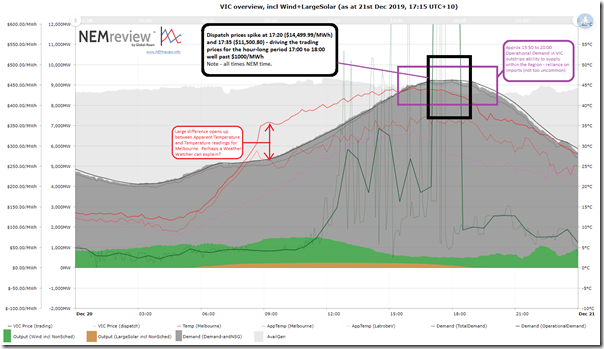
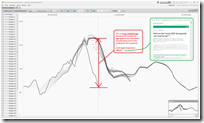
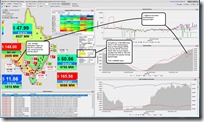
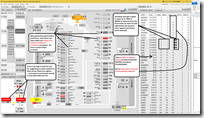
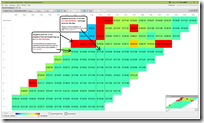
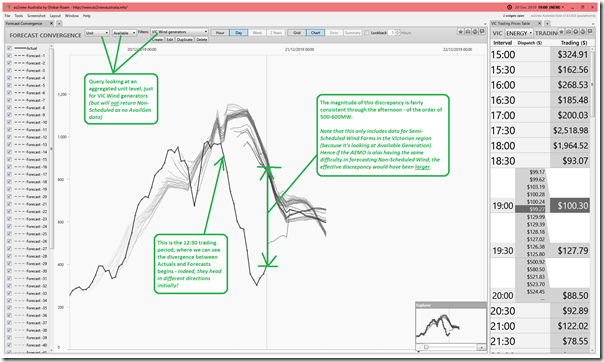
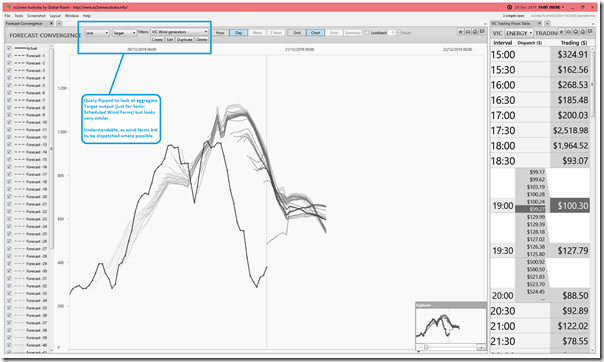
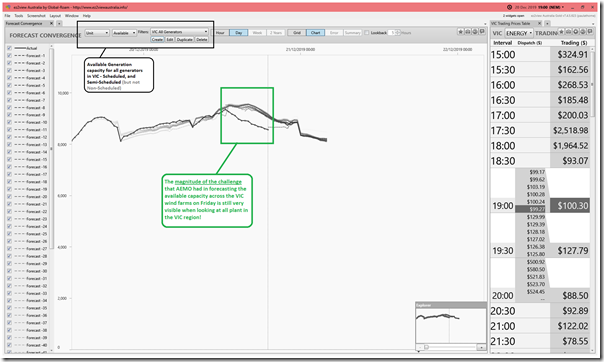
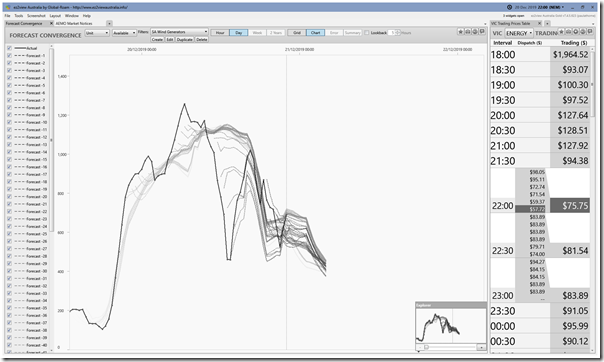
I live near the Macarthur Wind Farm, and was surprised that it was blowing a hot gale but the wind farm was only producing at <20% of capacity. For example at 17:20 NEM time, when the 5-minute Vic price spiked to $14,000/MWh, BoM's Hamilton Airport weather station recorded a wind speed of of 30 km/hr, gusting to 48 km/hr. Temperature was 40.6 degrees, having declined from a maximum of 44.5 degrees at 16:00 NEM time. The wind farm was only producing 60 MW (14.4% of capacity). It is rarely subject to grid constraints because it feeds into the 500 kV line to Heywood. Several Vic wind farms were off at the time including Mt Mercer, Mt Gellibrand, Murra Warra, and Waubra, while the operating Vic wind farms had low capacity factors despite being exposed to a similar wind resource. The SE SA wind farms, exposed to similar high winds and high temperatures had capacity factors of 60-80% much of the day, but went off at 17:20 NEM time with the loss of 200 MW.
Two hypotheses
1. When developers ordered generators for the Vic wind farms they didn't believe it was worthwhile paying any extra for high-temperature performance, because their contracts are only for the energy output without any premium for production when prices are high, whereas SA developers are more acquainted with such temperatures and have paid extra for better cooling systems in their generators.
2. TNSP's underestimated the degradation of their equipment performance over 40 degrees.
Until the pricing of power is changed, there will be times when, yes even solar and wind producers will, try to help the spot price up, its human nature.
The top price is simply just way too high, its too tempting.
But can the price ever be right without guaranteed dispatchability from every player at the regulator’s beck and call? Also presumably TNSPs would no doubt like to know what’s regularly required of them for that too.
I know Aldi have some cheap hardware from time to time but if it’s a necessity I go to Bunnings. It’s not that hard to work out the difference.
Some thing is wrong, no matter which way its looked at. The price of power has gone up 3 fold, and the fluctuations are simply unreal. The whole system, is a dogs breakfast.
We are now hitting the CRAZY high prices, and pretty Crazy low prices, more and more often, and everywhere in between.
Power is a needed for our system and country, and it needs to be stable in Both supply and price.
It is simply crazy, as it is 2019, almost 2020.